One stop best renovator for your kitchen basement
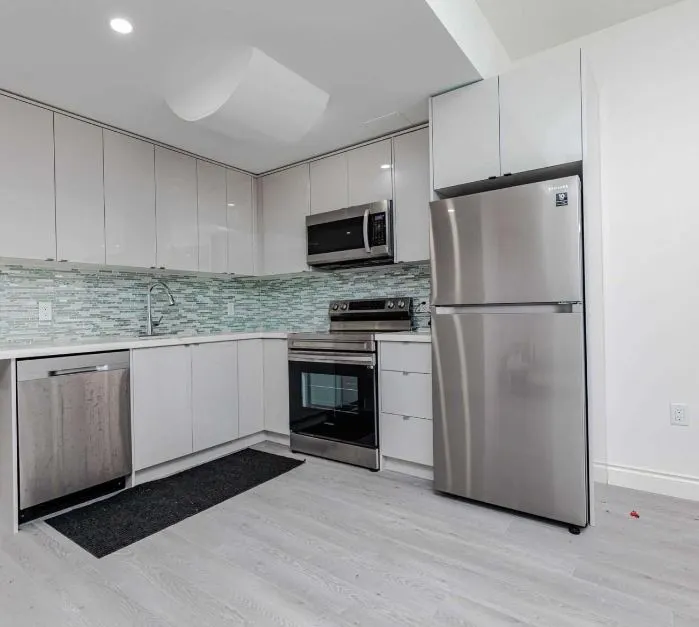
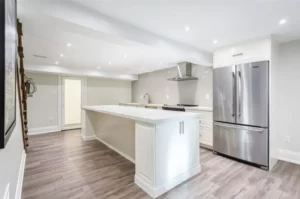
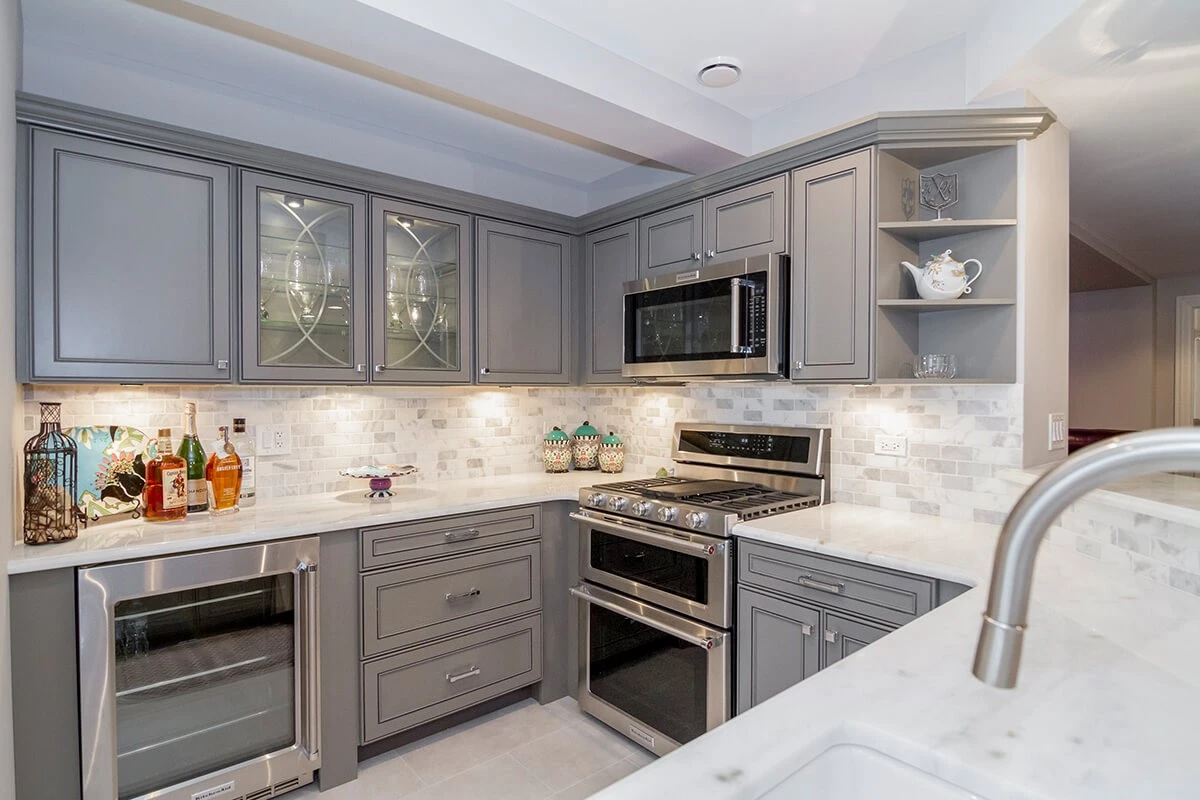
A guide to get you started on your basement kitchen
If you are considering renovating your basement or adding a kitchen to it, this article will provide you with the ultimate guide. A basement kitchen is a compact kitchen situated on the base floor of a house. There are several options available, ranging from a spacious kitchen with multiple appliances and ample counter space, to a basic kitchen with minimal cooking equipment and a few countertops. Regardless of the style you choose, thorough planning and designing are crucial, and that’s where our professional and efficient services come in to assist you.
Why should you get one?
You may be wondering why you would need a basement kitchen in the first place. There are several benefits to having one such as:

Convenience while entertaining guests
It provides convenience when entertaining guests. You can cook and entertain simultaneously without the hassle of running up and down the stairs. This could make it the perfect place for a family gathering.

Adds value to your home
A basement kitchen will add more value to your home. If you are looking to rent out your lower level, having a separate kitchen can increase the rental income by providing tenants with adequate privacy and convenience. Furthermore, if you plan to sell your house in the future, a basement kitchen can be a unique selling point.

Allow for more storage
Furthermore, a basement kitchen can provide additional storage space. This means you can store extra appliances and dishes without worrying about overflowing storage compartments in your main kitchen. Overall, a basement kitchen can offer many benefits and enhance the functionality of your home.
Basement kitchen ideas on a budget
Planning and installing a basement kitchen doesn’t have to break the bank or be out of your budget. With a few smart choices and some creativity, you can create a beautiful kitchen in cheap cost without exploding your budget.
One effective way to save money is to repurpose existing items in your home. Consider using old appliances and furniture, as new ones can be costly. Additionally, constructing countertops and cabinets with affordable raw materials can also help keep costs down. Although granite and marble countertops give a sleek and smooth finished look to your kitchen, they do lean towards the pricey side. Therefore to make it more accustomed to your budget you could opt for butcher’s block or concrete countertops.
Another way to cut costs is to take a DIY approach. For example, flooring is a key element of any kitchen, but it can be expensive. By using temporary flooring such as wood or laminate, which can be installed yourself, you can save on labor costs and easily upgrade your existing flooring.
With these budget-friendly tips, you can achieve a stylish and functional basement kitchen without overspending.
Basement Finishing Cost Calculator
Things to consider while installing a basement kitchen
It’s important to consider a number of factors when planning and constructing your new space. Here are some key things to keep in mind:
Permits
When renovating your basement kitchen in Canada, it’s crucial to obtain permits from the local building authority before starting any work. This includes obtaining electrical and plumbing permits, as required by building codes and regulations. Make sure to comply with all regulations to avoid any issues in the future. When designing your kitchen, consider the height of the base units and the corner units to ensure a functional and aesthetically pleasing layout.
Safety
When building a basement kitchen, safety should always be a top priority. It’s important to ensure that the layout of the space allows for easy access in case of emergencies. This includes planning for emergency exits, such as installing windows or doors that lead directly outside or building a separate stairway. Make sure to also consider the safety of the kitchen appliances and fixtures, such as choosing the appropriate size for your kitchen sink and faucet, and checking for any leaks in your plumbing. Additionally, be sure to comply with all building codes and regulations to ensure the safety of yourself and others who will be using the space. By taking these safety measures, you can create a functional and safe basement kitchen that meets all necessary standards.
Drainage
When it comes to renovating a basement kitchen, there are many design ideas that can add both style and functionality to your space. The home Depot offers a wide variety of options for kitchen fixtures and appliances, including sinks that come in various sizes and styles to suit your needs. While the cost of a basement kitchen renovation can vary depending on factors such as the scope of the project and the materials used, it’s important to invest in quality fixtures and hire a professional plumber to ensure that the plumbing and drainage lines are properly installed. Even if you have a small space to work with, there are still many ways to create a functional and stylish kitchen that meets your needs. With careful planning and the right resources, you can turn your basement into a beautiful and functional living space.
Ventilation
Proper ventilation is a crucial aspect of any kitchen, but it’s especially important in a basement space. Without adequate ventilation, cooking odors, smoke, and excess moisture can accumulate in the air, leading to unpleasant smells, poor air quality, and potential health hazards. To ensure proper ventilation in your basement kitchen, consider installing a range hood or exhaust fan that is appropriately sized for the space. This will help to remove smoke, steam, and cooking fumes from the air and prevent them from circulating throughout your home. Adding windows or vents can also help to increase air circulation and reduce moisture levels. Make sure to consult with a professional to determine the best ventilation options for your specific situation. With proper ventilation in place, you can enjoy a safe and comfortable basement kitchen that is free from unpleasant odors and harmful pollutants.
Basement kitchenette planning
Designing a basement kitchenette requires careful planning and consideration of various factors. A kitchenette is typically smaller in size compared to a standard kitchen, which means that you need to maximize the available space and be mindful of the appliances and fixtures you install.
One of the first things you need to consider is the layout. You will need to create a plan that includes the placement of appliances, countertops, and cabinets, taking into account the available space and any existing structures in the basement. It’s also essential to consider safety aspects such as emergency exits and ventilation, especially if the kitchenette is in a basement that lacks natural light and air circulation.
Another critical factor to consider is the appliances you want to install. In a kitchenette, you will likely have limited space, so it’s essential to choose appliances that fit into the available area. For instance, you may choose a compact refrigerator, a small stovetop, or a microwave oven instead of a full-sized stove and refrigerator.
Basement Kitchenette Design Tips
Designing a kitchenette in a basement requires thoughtful planning and attention to detail to create a space that is both functional and aesthetically pleasing. One of the biggest challenges of designing a basement kitchenette is the lack of natural light, which can make the space feel dark and cramped. To combat this issue, it is essential to use light neutral tones for the cabinets and walls.
Light colors reflect more light, making the room appear brighter and more spacious. White or neutral tones are the best options as they provide a clean and timeless look that complements any décor style. Additionally, using glossy finishes on cabinets and countertops can reflect light even more, making the space feel even brighter.
It is also important to select materials and appliances that are easy to clean and maintain. Basements can be prone to moisture and humidity, which can damage certain materials over time. Therefore, it is recommended to choose materials that are resistant to water damage, such as stainless steel or quartz countertops.
In a small space like a kitchenette, it is crucial to maximize storage capacity. Adding storage compartments, such as pull-out drawers and overhead cabinets, can help keep the space organized and clutter-free. Utilizing vertical space by installing shelving units or hooks can also provide additional storage options.
In summary, when designing a kitchenette in a basement, it is important to choose light neutral tones for the cabinetry and walls, use materials and appliances that are easy to clean and maintain, and maximize storage capacity. With the right design choices, even a basement kitchenette can become a beautiful and functional space.
The benefits:
Seclusion from guests:
Basement kitchens can be used as reserved kitchens for guests so that they don’t end up in your private space and at the same time can enjoy their stay with you and prepare treats for themselves.
Increased Storage:
More cabinetry, countertops, and shelving means more storage for your basement space. This can also be the perfect place to store extra appliances or serve ware that doesn’t currently have a home in your kitchen. We can also store extra kitchen supplies such as food and other groceries in the basement in bulk while only keeping a short stock in the main kitchen so that it remains neat and maintained.

Your Dream Basement Projects starts from here : Ignite your options with our complementary quotation
Basement Kitchen Layouts:
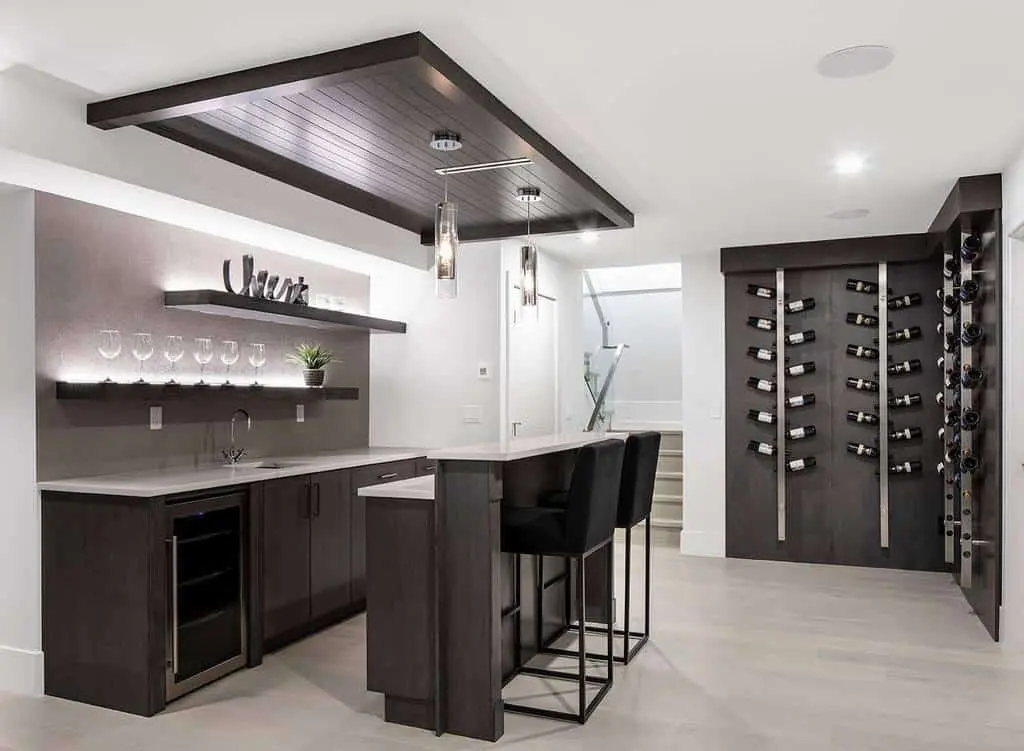
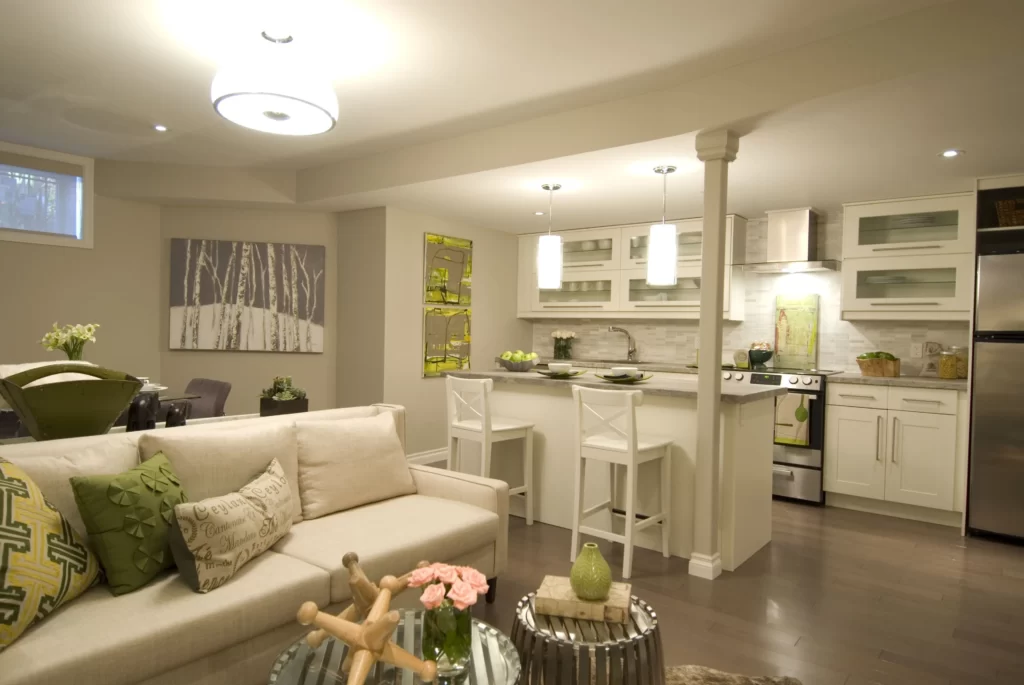
Basement Kitchen Design Layout for Small Basements:
Designing an IKEA kitchen layout can be both fun and challenging. With so many options for cabinets, drawers, sinks, and faucets, it can be difficult to know where to start. In this article, we will explore different IKEA kitchen layouts for different basement sizes, including galley kitchens, one-wall kitchens, island kitchens, two island kitchens, and open concept kitchens. We will also discuss different cabinet heights and sizes, including 30-inch cabinets, 36-inch cabinets, and 48-inch cabinets, as well as floating kitchen cabinets. Lastly, we will provide some ideas on how to design a cheap, yet stylish IKEA kitchen layout for your home.
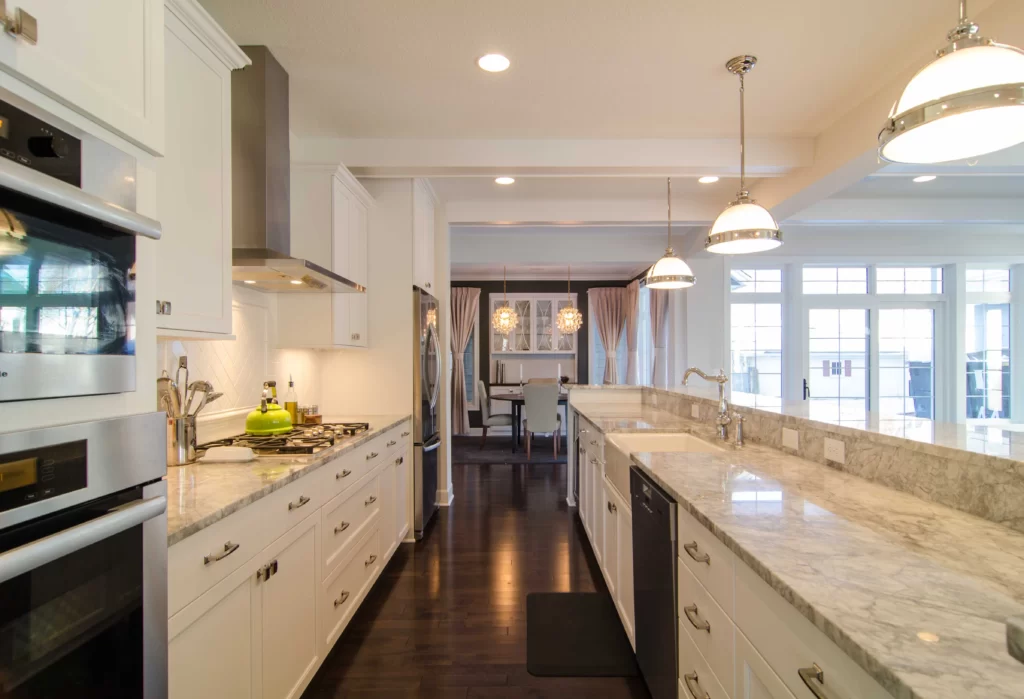
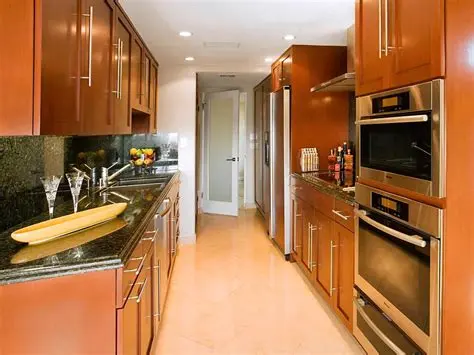
Galley Kitchen Layout:
A Galley kitchen is a great choice for small basements. It features two parallel slab counters that run alongside each other and are typically situated on opposite walls. This layout creates a streamlined and efficient work triangle that makes meal preparation a breeze. One downside of a Galley kitchen is the limited standing space between the two counters, which can make it challenging to accommodate multiple cooks or entertain guests. However, with careful planning and thoughtful design, it is possible to maximize the available space and create a comfortable and functional kitchen that meets your needs

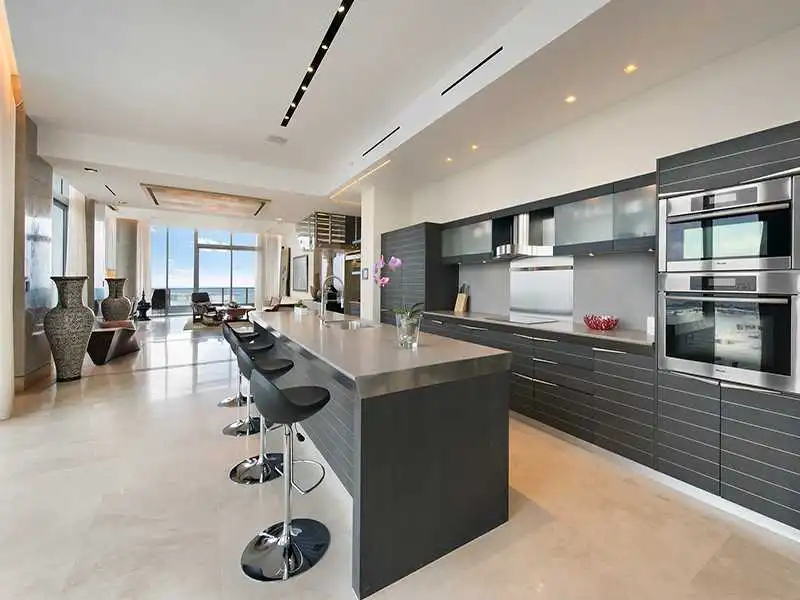
One Wall Kitchen:
A One Wall kitchen is ideal for small spaces or studio apartments. All the kitchen equipment, including the stove, appliances, and crockery, is placed along a single wall of the kitchen. This layout frees up valuable floor space and creates a more efficient work triangle. The One Wall kitchen layout offers a great opportunity to create an empty counter space opposite to the wall that has all the kitchen equipment. This can be used as a workspace for preparing food, serving meals, or even as a small dining area.
Basement Kitchen Layouts for MEDIUM-Sized Basement Kitchens:
When designing a medium-sized basement kitchen, there are two popular options for this type of kitchen are the island and peninsula layouts.
Island Kitchen:
An island kitchen layout is defined by a large counter or island situated in the center of the kitchen. This counter can be accessed from all sides, and is typically used for a variety of purposes such as food preparation, cooking, cleaning, and even dining. Because of its central location, an island counter allows multiple people to work in the kitchen at the same time without feeling crowded.
An island kitchen layout features a standalone kitchen island positioned in the center of the room. This layout provides a functional and stylish addition to the kitchen space. The island can be used for additional storage, preparation space, and even seating. It can serve as a central gathering place for family and friends, making it a great option for entertaining. Island kitchens can be customized to fit any design aesthetic, from traditional to modern.
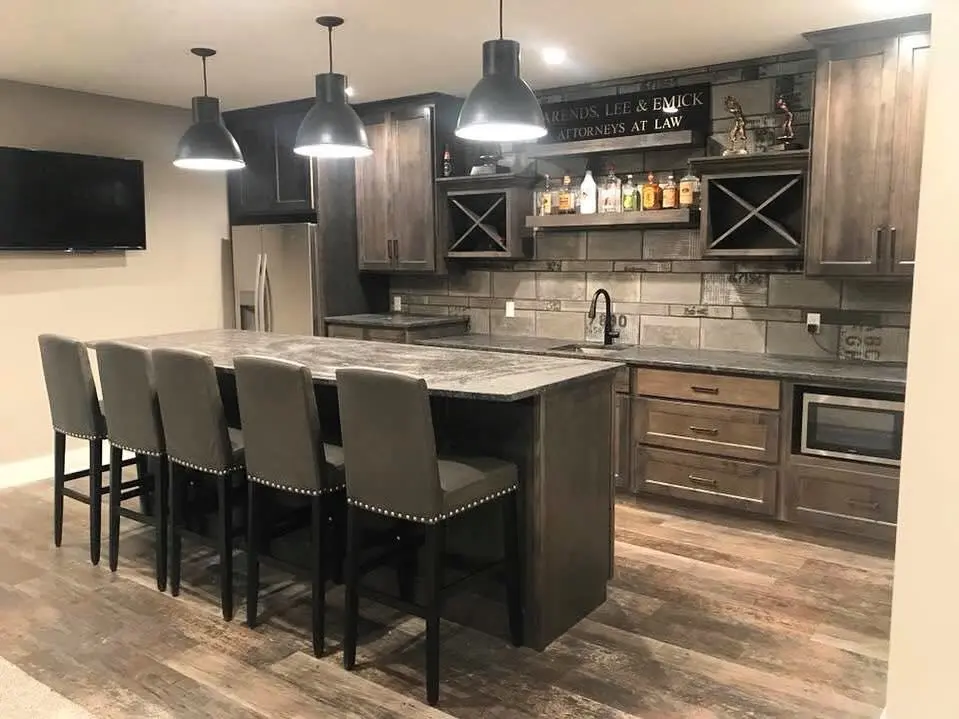
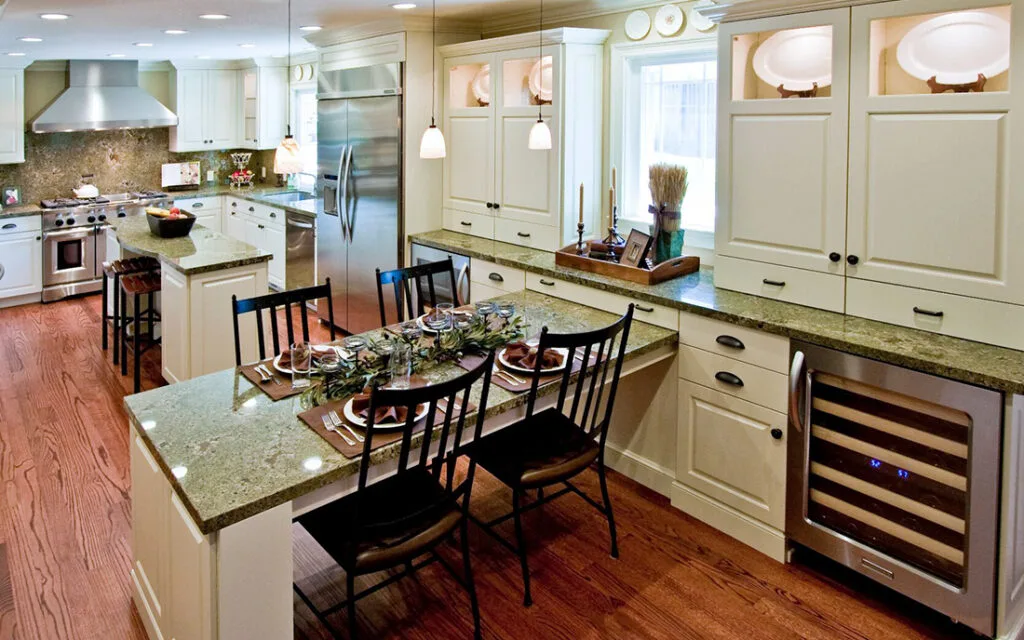
Peninsula layout:
A peninsula kitchen layout is similar to an island layout, with the main difference being that the peninsula is attached to the kitchen countertops on one end. This layout is ideal for creating a natural division between the kitchen and other living spaces. It provides additional counter space and storage while also acting as a breakfast bar or dining area.
Basement Kitchen Design Layout for Spacious Basements:
Two Island kitchen:
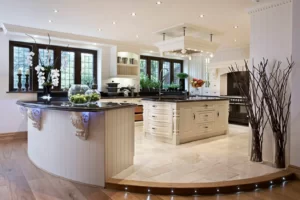
If you have a spacious basement and are considering an island kitchen layout for your renovation, you may want to consider the option of having two islands. This design provides even more counter space, storage, and versatility for your kitchen.
With two islands in your kitchen, you have the ability to designate specific areas for different tasks. For example, one island can be dedicated to food preparation and cooking, while the other can be used for dining and entertaining guests. This separation can make the kitchen feel more organized and efficient, as different tasks can be accomplished in different areas without interfering with each other.
Having two islands also allows for multiple people to work in the kitchen at the same time. This means that family members or guests can help with food preparation, cooking, or cleaning up, without getting in each other’s way. Plus, with two islands, there is even more space for seating and socializing, making your kitchen the perfect place to gather and relax.
Another advantage of a two island kitchen layout is that it can add a unique design element to your home. With two distinct areas, you can create a beautiful and functional space that reflects your personal style and taste. Whether you prefer a modern, sleek look or a more traditional aesthetic, two islands can be customized to fit your needs and preferences.
Open Concept Layout:

An open spaced kitchen is a wonderful way to connect your kitchen and living room seamlessly. By removing the physical barrier between these two spaces, you create a natural flow that allows you to move freely between the two areas without feeling like you’ve entered a completely different room.
This open concept design makes it easy to socialize with your guests while cooking or preparing food in the kitchen. You can chat with your guests in the living room while also keeping an eye on your food, making hosting and entertaining a breeze.
The integration of an open spaced kitchen can also make your home feel more spacious and airy, as the removal of walls and doors allows for natural light to flow throughout the space. Additionally, this design can provide a more modern and contemporary look to your home
Final Note!
Get in touch with us to create an amazing basement kitchen that fits your vision, all at an affordable price. We provide free price quotations and even offer a virtual tour of your dream basement kitchen before you make any investment. This way, you can see the design and layout come to life and make informed decisions about your project.
FAQs
What are the necessary considerations for building a basement kitchen?
Before building a basement kitchen, it’s essential to consider the ventilation, plumbing, electrical wiring, and natural light in the space. The kitchen must be adequately ventilated to prevent the buildup of cooking fumes, and the plumbing must be adequate to ensure proper drainage. Proper electrical wiring is also essential to ensure the safe use of kitchen appliances, and natural light is beneficial to create a pleasant environment.
How can I ensure that my basement kitchen meets building codes?
It’s crucial to consult with a licensed contractor or architect familiar with local building codes before beginning any basement kitchen project. Building codes can vary by location, and you will need to ensure compliance with all applicable regulations. Building permits and inspections may also be required.
Can I add a basement kitchen to my home without a permit?
No, building permits are required for most basement renovations, including the addition of a kitchen. Failing to obtain the necessary permits can result in fines and legal issues.
What types of appliances should I install in a basement kitchen?
The appliances you choose to install in your basement kitchen should be appropriate for the space and your cooking needs. Consider installing energy-efficient appliances that are designed for smaller spaces, such as a compact refrigerator, dishwasher, and oven.
How can I maximize storage in my basement kitchen?
When designing your basement kitchen, consider incorporating custom storage solutions, such as built-in shelves, cabinets, or a pantry. You can also maximize storage by choosing multi-functional furniture or using under-cabinet storage solutions.
Can I install a gas range in my basement kitchen?
Yes, it’s possible to install a gas range in your basement kitchen, but it will require additional considerations, such as proper ventilation and access to a gas line. It’s essential to consult with a licensed contractor or plumber familiar with gas line installations before proceeding.
What flooring options are suitable for a basement kitchen?
When choosing flooring for your basement kitchen, consider materials that are moisture-resistant and easy to clean, such as tile, vinyl, or concrete. Avoid materials that are susceptible to water damage, such as hardwood or carpet.
